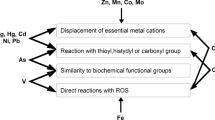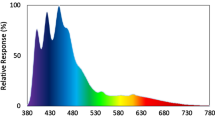Abstract
The Mozambique tilapia (Oreochromis mossambicus) is prone to osmoregulatory disturbances when faced with fluctuating ambient temperatures. To investigate the underlying causes of this phenomenon, freshwater (FW)- and seawater (SW)-acclimated tilapia were transferred to 15, 25, or 35°C for 2 weeks, and along with typically used indicators of osmoregulatory status [plasma osmolality and branchial and intestinal specific Na+, K+-ATPase (NKA) activity], we used tissue microarrays (TMA) and laser-scanning cytometry (LSC) to characterize the effects of temperature acclimation. Tissue microarrays were stained with fluorescently labeled anti-Na+, K+-ATPase antibodies that allowed for the quantification of NKA abundance per unit area within individual branchial mitochondria-rich cells (MRCs) as well as sections of renal tissue. Mitochondria-rich cell counts and estimates of size were carried out for each treatment by the detection of DASPMI fluorescence. The combined analyses showed that SW fish have larger but fewer MRCs that contain more NKA per unit area. After a 2-week acclimation to 15°C tilapia experienced osmotic imbalances in both FW and SW that were likely due to low NKA activity. SW-acclimated fish compensated for the low activity by increasing MRC size and subsequently the concentration of NKA within MRCs. Although there were no signs of osmotic stress in FW-acclimated tilapia at 25°C, there was an increased NKA capacity that was most likely mediated by a higher MRC count. We conclude on the basis of the different responses to temperature acclimation that salinity-induced changes in the NKA concentration of MRCs alter thermal tolerance limits of tilapia.









Similar content being viewed by others
Abbreviations
- TMA:
-
Tissue microarray
- LSC:
-
Laser scanning cytometry
- NKA:
-
Na+, K+-ATPase
- MRC:
-
Mitochondria-rich Cell
- DAPSMI:
-
Dimethylaminostyrylmethylpyridiniumiodide
- g l−1 :
-
Grams per liter
- °C:
-
Degrees celcius
- FW:
-
Freshwater
- SW:
-
Seawater
- PI:
-
Propidium iodide
References
Al Amoudi M, El-Sayed A, Ghobashy A (1996) Effects of thermal and thero-haline shocks on survival and osmotic concentration of the tilapias Oreochromis mossambicus and Oreeochromis aureus x Oreochromis niloticus hybrids. J World Aquac Soc 27:456–461
Bijvelds MJC, Kolar Z, Wendelaaar Bonga S, Flik G (1997) Mg2+ transport in plasma membrane vesicles of renal epithelium of the Mozambique tilapia (Oreochromis mossambicus). J Exp Biol 200:1931–1939
Bubendorf L, Nocito A, Moch H, Sauter G (2001) Tissue microarray (TMA) technology: miniaturized pathology archives for high-throughput in situ studies. J Pathol 195:72–79
Dang Z, Balm P, Flik G, Wendelaar Bonga S, Lock R (2000) Cortisol increases Na+, K+-ATPase density in plasma membranes of gill chloride cells in the freshwater tilapia Oreochromis mossambicus. J Exp Biol 203:2349–2355
Dange AD (1985) Branchial Na+-K+-ATPase activity during osmotic adjustments in two freshwater euryhaline teleosts, tilapia (Sarotherodon mossambicus) and orange chromid (Etroplus maculatus). Mar Biol 87:101–107
Gonzalez RJ, McDonald DG (1992) The relationship between oxygen consumption and ion loss in a freshwater fish. J Exp Biol 163:317–332
Gonzalez RJ, McDonald DG (1994) The relationship between oxygen uptake and ion loss in fish from diverse habitats. J Exp Biol 190:95–108
Handeland SO, Bereg A, Bjornsson BT, Lie O, Stefanson SO (2000) Seawater adaptation by out of season Atlantic salmon (Salmo salar L.) smolts at different temperatures. Aquaculture 181:377–396
Hochachka PW, Somero GN (2002) Biochemical adaptation: mechanism and process in physiological evolution. Oxford University Press, New York
Hurlbert AH, Anderson T, Sturm KK, Hurlbert SH (2007) Fish and fish-eating birds at the Salton Sea: a century of boom and bust. Hydrobiologia (in press)
Imsland AK, Gunnarsson S, Foss A, Stefansson SO (2003) Gill Na+, K+-ATPase activity, plasma chloride and osmolality in juvenile turbot (Scophthalmus maximus) reared at different temperatures and salinities. Aquaculture 218:671–683
Johnston CE, Cheverie JC (1985) Comparative analysis of ionoregulation in rainbow trout (Salmo gairdneri) of different sizes following rapid and slow salinity adaptation. Can J Fish Aquat Sci 42:1994–2003
Kültz D, Somero GN (1995) Osmotic and thermal effects on in situ ATPase activity in permeabilized gill epithelial cells of the fish Gillichthys mirablis. J Exp Biol 198:1883–1894
Kültz D, Bastrop R, Jurss K, Siebers D (1992) Mitrochondrial-rich (MR) cells and the activities of the Na+/K+-ATPase and carbonic anhydrase in the gill and opercular epithelium of Oreochromis mossambicus adapted to various salinities. Comp Biochem Physiol 102B:293–301
Lima R, Kültz D (2004) Laser scanning cytometry and tissue microarray analysis of salinity effects on killifish chloride cells. J Exp Biol 207:1729–1739
Metz JR, van den Burg EH, Wendelaar-Bonga SE, Flik G (2003) Regulation of Branchial Na+/K+-ATPase in common carp Cyprinus carpio acclimated to different temperatures. J Exp Biol 206:2273–2280
Robertson JC, Hazel JR (1999) Influence of temperature and membrane lipid composition on the osmotic water permeability of teleost gills. Physiol Biochem Zool 72:623–632
Sardella BA, Brauner CJ (2007) Cold temperature-induced osmoregulatory failure: the physiological basis for tilapia winter mortality in the Salton Sea? California Fish and Game (in press)
Sardella BA, Cooper J, Gonzalez R, Brauner CJ (2004a) The effect of temperature on juvenile Mozambique tilapia hybrids (Oreochromis mossambicus x O. urolepis hornorum) exposed to full-strength and hypersaline seawater. Comp Biochem Physiol A 137:621–629
Sardella BA, Matey V, Cooper J, Gonzalez RJ, Brauner CJ (2004b) Physiological, biochemical, and morphological indicators of osmoregulatory stress in California Mozambique tilapia (Oreochromis mossambicus x O. urolepis hornorum) exposed to hypersaline water. J Exp Biol 207:1399–1413
Staurnes M, Sigholt T, Asgard T, Baeverfjord G (2001) Effects of a temperature shift on seawater challenge test performance in Atlantic salmon (Salmo salar) smolt. Aquaculture 201:153–159
Stickney RR (1986) Tilapia tolerance of saline waters: a review. Prog Fish Cult 48:161–167
van der Heijden AJH, Verbost P, Eygensteyn J, Wendelaar Bonga SE, Flik G (1997) Mitochondria-rich cells in gills of tilapia (Oreochromis mossmabicus) adapted to fresh water or sea water: quantification by confocal laser scanning microscopy. J Exp Biol 200:55–64
Welch TJ, Stauffer JR, Morgan RP (1989) Temperature preference as an indicator of the chronic toxicity of cupric ions to Mozambique tilapia. Bull Environ Cont Toxic 43:761–768
Wilson RW, Grosell M (2003) Intestinal bicarbonate secretion in marine teleost fish- source of bicarbonate, pH sensitivity, and consequences for whole animal acid-base and calcium homeostasis. Biochim Biophys 1618:163–174
Wilson R, Gilmour K, Henry R, Wood C (1996) Intestinal base excretion in the seawater-adapted rainbow trout: a role in acid-base balance? J Exp Biol 199:2331–2343
Wilson RW, Wilson JM, Grosell M (2002) Intestinal bicarbonate secretion by marine teleost fish-why and how? Biochim Biophys 1566:182–193
Acknowledgments
There are several people we wish to thank for their support of this work directly or indirectly; including Peter Allen, Sally Mak, Paul Lutes, Stephanie Chan, and Christa Woodley of the University of California at Davis, as well as Jeff Richards, Rosalind Leggatt, and Patricia Schulte of the University of British Columbia. This work was supported by NSF grant IOB-0542755 to DK, as well as an NSERC Discovery Grant to CJB.
Author information
Authors and Affiliations
Corresponding author
Additional information
Communicated by I.D. Hume.
Rights and permissions
About this article
Cite this article
Sardella, B.A., Kültz, D., Cech, J.J. et al. Salinity-dependent changes in Na+/K+-ATPase content of mitochondria-rich cells contribute to differences in thermal tolerance of Mozambique tilapia. J Comp Physiol B 178, 249–256 (2008). https://doi.org/10.1007/s00360-007-0211-2
Received:
Revised:
Accepted:
Published:
Issue Date:
DOI: https://doi.org/10.1007/s00360-007-0211-2




